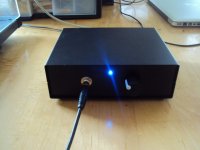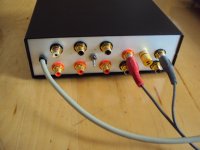I know it can be balanced so there's no DC out...my concern is thermal drift.....simulation is one thing reality another...and it just may be so that all balances out and all works brilliantly with no offset problem,, 🙂
if not i believe it would be good to mapped the means to isolate the possible drift...Ie by separation of the two stages or to add it at the output..
if not i believe it would be good to mapped the means to isolate the possible drift...Ie by separation of the two stages or to add it at the output..
Post 2679, are you sure that the buffer fets will conduct without a gate current in the input fet ?
according to simulation there's is 15mA through.. and no problems in conduction....would you like positive potential..??
If you keep the 1Mohn to GND.. then to keep the RIAA-curve.. the resistor to GND must be increased to 400K..or the base response suffers..best would be if drift is not an issue and that the DC-cap is not needed...
Yes, the resistor value can be split. I did that before. We could of cause use a servo. More parts though and a discussion what sounds better : cap or servo.
let's see how it drifts......
A 100 nF cap can be of very very good quality...but will for sure make som kind of imprint and form some kind of signature on the circuit...but then again so will anything else also...🙂
A 100 nF cap can be of very very good quality...but will for sure make som kind of imprint and form some kind of signature on the circuit...but then again so will anything else also...🙂
There are some inexpensive High Quality Teflon 100n caps available 🙂
These are very transparent sounding (for a teflon) and very extended.
Servo might be good but it would add to the complexity of the circuit.
These are very transparent sounding (for a teflon) and very extended.
Servo might be good but it would add to the complexity of the circuit.
What are they ? Russian ?
I took a little rest over the weekend. The last weeks saw me very busy designing and building with my team 3 new phono stages for the Milano Top Audio show. They will be shown under the L`Art du Son label with Well Tempered turntables and Decca cartridges.
Martina will be there to demonstrate.
Nevertheless i build one Starless input stage. I could not make it work floating but this is a good thing. I would have needed a separate supply for the buffer and this is not necessary any more. GB is more or less the same then the PEN circuit so i do not see a big advantage in cascoding the Fets. With unselected Fets and BJTs and 1% resistors i have some input and output offset. That can be trimmed away or servoed. I will build the circuit nevertheless. Maybe it sounds better. As you may know me there is also a plan B. An even simpler MC phono. I gave it the name "Naked Truth". That one is not possible to simplify any more or it does not work.
I took a little rest over the weekend. The last weeks saw me very busy designing and building with my team 3 new phono stages for the Milano Top Audio show. They will be shown under the L`Art du Son label with Well Tempered turntables and Decca cartridges.
Martina will be there to demonstrate.
Nevertheless i build one Starless input stage. I could not make it work floating but this is a good thing. I would have needed a separate supply for the buffer and this is not necessary any more. GB is more or less the same then the PEN circuit so i do not see a big advantage in cascoding the Fets. With unselected Fets and BJTs and 1% resistors i have some input and output offset. That can be trimmed away or servoed. I will build the circuit nevertheless. Maybe it sounds better. As you may know me there is also a plan B. An even simpler MC phono. I gave it the name "Naked Truth". That one is not possible to simplify any more or it does not work.
I believe that caps should be mechanically stable... which Teflons rarely are.. to me the best caps is tin polystyrene..sad to see them disappear....I do also like tin/polypropylene caps...they seem to add a pleasant calmness to the proceedings, but lets not make this a cap discussion as I hope Joachim can make it work without...🙂
LCR COMPONENTS|EXFS/HR 6800PF +/- 1%|CAPACITOR, 6.8NF, 63V | Farnell Danmark..
These are as far as I can tell extended Tin-foil/Polystyrene capacitors...would for me be good choice for a RIAA..both for correction and coupling...sorry to derail...again..🙂
These are as far as I can tell extended Tin-foil/Polystyrene capacitors...would for me be good choice for a RIAA..both for correction and coupling...sorry to derail...again..🙂
You are right about the riaa caps. I also found Tin-foil/polystyrenes to be the best choice on the Riaa, but for coupling I find FT-3 very good.
Why do you state Teflon are not mechanically stable ? I had issues with FT-1 but I do not know the cause (It seems the capacitance is no very stable with these).
FT-3 are very good but big.
Why do you state Teflon are not mechanically stable ? I had issues with FT-1 but I do not know the cause (It seems the capacitance is no very stable with these).
FT-3 are very good but big.
i'm very interested your phono match Well tempered,because i'm Well Tempered user,great turntable and affordable pricesWhat are they ? Russian ?
I took a little rest over the weekend. The last weeks saw me very busy designing and building with my team 3 new phono stages for the Milano Top Audio show. They will be shown under the L`Art du Son label with Well Tempered turntables and Decca cartridges.
Martina will be there to demonstrate.
Nevertheless i build one Starless input stage. I could not make it work floating but this is a good thing. I would have needed a separate supply for the buffer and this is not necessary any more. GB is more or less the same then the PEN circuit so i do not see a big advantage in cascoding the Fets. With unselected Fets and BJTs and 1% resistors i have some input and output offset. That can be trimmed away or servoed. I will build the circuit nevertheless. Maybe it sounds better. As you may know me there is also a plan B. An even simpler MC phono. I gave it the name "Naked Truth". That one is not possible to simplify any more or it does not work.
The problem with Teflon is that the material does not crimp..and is very very soft,, so while having good electrical properties, it must rely on the wrapping for mechanical stability.
and thus they are sometimes coated with glass and other stabilizing materials.
Teflon capacitors also have the problem that the teflon-foil is rather thick, which in return leads to larger plates, and as such longer current paths and more/higher inductance. So that the price for the better isolation material is big sizes and compromises in other important areas,, and to me the Cons are larger than the Pros...I do think they perform well in certain areas, as they are very reliable, and thus have been used in military communication equipment.
and thus they are sometimes coated with glass and other stabilizing materials.
Teflon capacitors also have the problem that the teflon-foil is rather thick, which in return leads to larger plates, and as such longer current paths and more/higher inductance. So that the price for the better isolation material is big sizes and compromises in other important areas,, and to me the Cons are larger than the Pros...I do think they perform well in certain areas, as they are very reliable, and thus have been used in military communication equipment.
samsamsam, the good thing is that one of the phono stages will be affordable and it is powered from the new Well Tempered PSU. It has a lot of configuring options. It has MM and MC switchable and adjustable in resistance and capacitance, it has a line input and a volume control and it has a headphone amp. I will later post a picture of the prototype.
I do not want to say more because this thread is not meant for promotion.
I do not want to say more because this thread is not meant for promotion.

